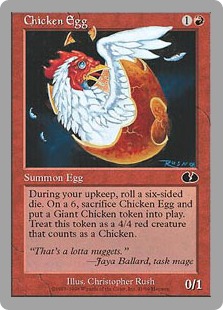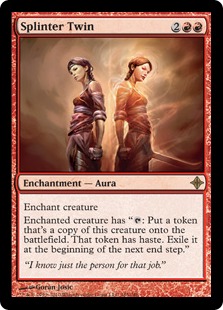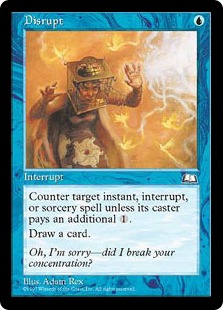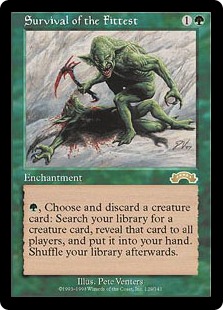
Meyou takes a look at what scientific observations can be made into the construction and makeup of successful decks among many formats, and what these observations might mean.
Magic is a very complicated game to understand. In fact, that is an understatement. Teaching the mechanics of the game can be quite the daunting task. If you can believe it, teaching new players how to build a deck is even more daunting. The question on every player’s mind, thus, is: what makes a good deck? How do you build a good deck? What is the secret to brewing?
If a new player asked you how to build a deck, what would you tell them?
The Question or the Hypothesis

Part of the scientific method that I feel gets largely ignored is the observation. This is mostly because observations are meant to be a series of observations. Certainly, we can begin the process of the scientific method by a single observation. It can be that eureka moment that shakes the scientific community at its foundation. In most instances, this is not the case. A series of observations ensures the researcher isn’t jumping to conclusions. Only after such do we ask questions. It can be argued that we ask the question before we make observations. Such a case is more of a philosophical question of what comes first, the chicken or the egg.
In any case, only after a series of observations do questions begin to form. The hypothesis is a question formed from those observations that we can test. When most people use the word theory, they should actually be using the word hypothesis. A theory is a set of hypotheses reinforcing each other over and over again. The reason the Theory of Evolution is a theory is because experiments and scientific knowledge has reinforced this over and over again. It has proven the test of time. A step up from theory is the Law. The Law of Thermodynamics or Law of Gravity are irrefutable: a Law of whatever cannot be questioned.
Like any good student, I did my literature review by observing many, many deck lists from the top finishing decks. Some were from the present, some were from the past. As I did so, I began to notice patterns. Keep in mind, there were deviations to the numbers that I am proposing. However, those numbers revolve around a mean, otherwise known as an average. I will also suggest reasons for those deviations from the norm. The numbers we will commonly see are eight, twelve, and sixteen.
The Eight/Eight Split Hypothesis

One of the most fundamental parts of the game is the opening hand. There are certain spells we hope are in that initial seven. What every player really hopes for is the God hand: the perfect opening seven. How do we increase our odds? We add extra copies of course. One of my least favorite decks of Magic’s past was a deck around the time of Odyssey block. It was a Red/Green deck whose objective was a turn two Stone Rain or Call of the Herd. Rinse and repeat. To increase its odds, it played four Llanowar Elves and four Birds of Paradise. By playing eight one mana accelerants, it almost guaranteed having one in the opening hand.
One would think that seven was the lucky number. Over time, I think Magic’s history has shown that eight is the correct number in the majority of cases. The number can be seen very often in two card combo decks that I simply refer to as an 8/8 split. As a visual example, the Sneak and Show deck from Legacy showcases this pattern. There are many, many examples that can be found over and over again. From Legacy, we have Reanimator running the split in reanimation spells and creatures. Before the ban-hammer, Fauna Shaman complimented Survival of the Fittest in various builds. Enchantment lovers have Argothian Enchantress and Enchantress's Presence. Omni-Tell has Show and Tell and Dream Halls. With the plethora of cards in the Eternal formats, it can also be seen in the Modern format as well. In a number of various Pod builds, Chord of Calling compliments the Birthing Pod strategy. How about Splinter Twin and Kiki-Jiki, Mirror Breaker? Storm can run the Goblin Electromancer and Pyromancer Ascension that again compliments the same strategy.
| Sneak and Show: Kelvin Young - 6th Place at StarCityGames.com Legacy Open on 3/23/2014Magic OnlineOCTGN2ApprenticeBuy These Cards | ||
|---|---|---|
|
Creatures 4 Griselbrand 4 Emrakul, the Aeons Torn Planeswalkers 2 Jace, the Mind Sculptor Spells 4 Show and Tell 4 Sneak Attack 3 Gitaxian Probe 3 Spell Pierce 4 Ponder 4 Brainstorm 1 Misdirection 4 Lotus Petal 4 Force of Will | Lands 3 Volcanic Island 3 Polluted Delta 1 Mountain 3 Island 3 Ancient Tomb 2 City of Traitors 4 Scalding Tarn | Sideboard 2 Flusterstorm 4 Leyline of Sanctity 2 Echoing Truth 1 Misdirection 1 Intuition 2 Tormod's Crypt 2 Pyroblast 1 Red Elemental Blast |
The 8/8 split doesn’t always need to be complimentary. As another visual example, we have an oldie in the form of the Legacy deck called Dreadstill before the printing of Abrupt Decay. The five to eight Stifle effects lets Phyrexian Dreadnought stay on the battlefield. Without the kill in hand, the deck stalled with Counterbalance that was enabled by Brainstorms and Sensei's Divining Top. A more present example is Legacy Elves, running a Natural Order and Glimpse of Nature package, as another show of a modified 8/8 split.
| Dreadstill: Rich Shay - 1st Place at Miscellaneous on 9/12/2010Magic OnlineOCTGN2ApprenticeBuy These Cards | ||
|---|---|---|
|
Creatures 4 Phyrexian Dreadnought 3 Trinket Mage 3 Dark Confidant Planeswalkers 2 Jace, the Mind Sculptor Spells 4 Stifle 1 Trickbind 3 Counterbalance 3 Sensei's Divining Top 4 Brainstorm 2 Spell Snare 1 Engineered Explosives 3 Standstill 2 Daze 4 Force of Will | Lands 4 Mishra's Factory 3 Underground Sea 2 Tundra 3 Wasteland 2 Polluted Delta 4 Flooded Strand 3 Island | Sideboard 3 Spell Pierce 1 Relic of Progenitus 1 Pithing Needle 1 Plains 2 Perish 3 Peacekeeper 1 Tormod's Crypt 3 Swords to Plowshares |
There is a question to ask here. Are the 8/8 split decks more successful than their counterparts who are only running one set of enablers? My hypothesis is the decks running another enabler are more successful. Part of this conversation was inspired by the recent success of Food Chain at a Legacy event. Not that I am questioning the power of its combo with Misthollow Griffin, it’s the fact the deck hinges solely on Food Chain. With only four cards in the deck, it is much harder to find the combo. Sure, every once in a while those decks run hot and win because there opponent stumbles. I don’t think good deck design should hinge on whether my opponent got unlucky.
Quest for the Holy Relic is a card that I feel makes my point that people have tried to make work in the Modern format. Sure, turning a Glint Hawk into 8/8 Vindicate on a stick by slapping on an Argentum Armor for free is very tantalizing. However, the deck flounders when it doesn’t draw a Quest for the Holy Relic. I suppose we could question its power level, but the deck suffers from not having another enabler. Those decks are only running a 4/4 split in a sense. It is a big if, but the unbanning of Stoneforge Mystic could enable the deck. By no way am I calling for an unbanning. I am simply pointing out the little artificer could enable the viability of the deck.
How about a different approach? Let’s look at Æther Vial or Bitterblossom. Back in the day, the start no opponent wanted to see was a turn one Thoughtseize followed by a turn two Bitterblossom. It was the power opening. Decks in Legacy that use Æther Vial display a completely different power level with a turn one Vial. The display of power from those starts are completely different than any other. I am reminded of this as I have been testing various lists of Merfolk for Legacy. The deck has lost a lot of its old glory as it has almost disappeared from the top decks of tournaments. An opening hand with the one mana artifact is completely different than other starts.
Let’s go back to that central question I asked earlier. What would I tell a new player about deck construction? I would advise them against playing decks that try to run 4/4 split. They should focus on decks that have a game plan of having eight enablers with eight compatible pieces. This answer also brings up another aspect of this discussion. What about the rest of the deck? Certainly, tutors, card draw and an engine can be included in the deck. Such a discussion is much more complicated and a topic in of itself. The segment I want to talk about is disruption.
The Disruption Hypothesis

So you have educated a player about the two-card combo decks. The worry is they will want to tweak their deck. Let’s take a Legacy Reanimator deck. A feasible move would be to remove those counterspells and discard effects for more combo pieces. The combo pieces are so good; wouldn’t more make the deck better? The answer is no. Most successful decks run an array of disruption. Just look at those sideboards. Very rarely do you see somebody side in a Tarmogoyf. Players board in disruption. Now, disruption could be counterspells and discard effects, but I consider other effects that protect your game plan to also be a form of disruption. The point is to protect a decks game plan or interfere with an opponent’s game plan.
How much disruption do we need? I think the easier way to approach this is to look at how many creatures many successful decks run in their board. A very common number in eternal formats is the number twelve. A very prominent example for your visual pleasure below is the popular RUG-Delver decks in Legacy.
| RUG Delver: Stephen Mann - 1st Place at StarCityGames.com Legacy Open on 3/2/2014Magic OnlineOCTGN2ApprenticeBuy These Cards | ||
|---|---|---|
|
Creatures 4 Delver of Secrets 4 Tarmogoyf 4 Nimble Mongoose Spells 2 Gitaxian Probe 2 Dismember 2 Spell Pierce 4 Ponder 4 Stifle 4 Daze 4 Brainstorm 4 Force of Will 4 Lightning Bolt | Lands 4 Scalding Tarn 2 Polluted Delta 2 Flooded Strand 3 Volcanic Island 3 Tropical Island 4 Wasteland | Sideboard 1 True-Name Nemesis 2 Grafdigger's Cage 1 Flusterstorm 1 Surgical Extraction 1 Spell Pierce 1 Vendilion Clique 2 Grim Lavamancer 3 Submerge 3 Pyroblast |
If one looks at any of these “fair” decks of the eternal formats, twelve is very prominent. In the recently successful Infect decks of Legacy, we see twelve infect creatures if we include Inkmoth Nexus. I suppose it could be argued there are sixteen, but it all depends on one’s viewpoint. Hexproof in Modern runs twelve creatures. Legacy BUG runs twelve. Many, many of the Legacy decks run twelve creatures. The rest of those decks run disruption. Their sideboards are filled with disruption. Very rarely do we find “vanilla” creatures in those decks. Tarmogoyf is a vanilla creature in terms of deck construction. Yes, it is very good. Yes, it has killed a lot of people, but the card itself doesn’t interfere with the opponent’s game plan. Vendilion Clique on the other hand can go to great lengths to disrupt an opponent’s perfect hand. Whoops, there just went a piece to your combo.
Deviations are allowed as can be observed by the popular Death and Taxes in the Legacy Format as can be seen below. There are certainly more than twelve creatures in those decks. However, many of those creatures are not vanilla creatures. Mother of Runes protects the army of beaters. Thalia, Guardian of Thraben interferes with the opponent’s spells. Phyrexian Revoker has neutered many a Griselbrand or Jace, the Mind Sculptor. The deck’s creatures are disruptive little monsters. In general, when we look at decks running more than the twelve, those creatures are more than vanillas. Mono-Blue Devotion in Standard at the moment comes to mind.
| Death and Taxes: Colin Logan - 11th Place at StarCityGames.com Legacy Open on 3/23/2014Magic OnlineOCTGN2ApprenticeBuy These Cards | ||
|---|---|---|
|
Creatures 1 Brimaz, King of Oreskos 4 Stoneforge Mystic 3 Serra Avenger 4 Mother of Runes 1 Spirit of the Labyrinth 4 Thalia, Guardian of Thraben 4 Phyrexian Revoker 3 Flickerwisp 2 Aven Mindcensor Spells 1 Umezawa's Jitte 4 Æther Vial 1 Sword of Fire and Ice 4 Swords to Plowshares 1 Batterskull | Lands 1 Horizon Canopy 1 Eiganjo Castle 10 Plains 4 Rishadan Port 4 Wasteland 3 Karakas | Sideboard 2 Rest in Peace 1 Grafdigger's Cage 1 Ratchet Bomb 1 Ethersworn Canonist 2 Wilt-Leaf Liege 1 Oblivion Ring 1 Manriki-Gusari 1 Meekstone 2 Enlightened Tutor 2 Cataclysm 1 Moat |
The Standard Format appears to revolve around sixteen. Mono-Black Devotion below is something that I would point to for reference as the standard for sixteen. No more. No less. (Sorry, watching Phantom Menace as I type). This is the pattern. Mono-Black Devotion could easily run Nightveil Specter and etc. The successful decks don’t. Again, I think this comes back to the basics. How many win conditions do you need? So, you have a Desecration Demon on the board and there are no creatures on your opponent’s side of the battlefield. Do you really need another win-condition? As before, I think it comes down to math. A player doesn’t need more than a set of sixteen win conditions in their deck. It is enough. The rest of deck’s space is much better utilized to run disruption to mess with the opponent’s plans.
| Mono-Black Devotion: Yuuya Watanabe - 1st Place at Grand Prix on 3/30/2014Magic OnlineOCTGN2ApprenticeBuy These Cards | ||
|---|---|---|
|
Creatures 4 Gray Merchant of Asphodel 4 Lifebane Zombie 4 Pack Rat 4 Desecration Demon Spells 4 Hero's Downfall 4 Devour Flesh 1 Ultimate Price 4 Underworld Connections 4 Thoughtseize 1 Duress 1 Bile Blight | Lands 1 Temple of Silence 1 Temple of Deceit 4 Mutavault 19 Swamp | Sideboard 1 Bile Blight 2 Erebos, God of the Dead 2 Read the Bones 4 Staff of the Death Magus 3 Doom Blade 3 Duress |
Deviations
I will concede Magic is a much more complicated game than I have alluded to in this article. However, I believe in my hypotheses may be the core of deck building. We can also certainly deviate from the core. The important aspect I believe is the core of deck building gives it context. Certainly, decks like the current Splinter Twin decks in Modern don’t run a full 8/8 split. Many Splinter Twin decks only run one or two Kiki-Jiki, Mirror Breakers in their decks. However, those decks run a ton of card draw with Remands and Cryptic Commands that draw into those combo pieces. Tutoring is also another way to cheat cutting multiply copies of those combo pieces.
I have realized I have talked mostly about Eternal formats, but they are such nice clean examples. Standard can be more difficult to illustrate. Jund Monsters though with four Elvish Mystic and Sylvan Caryatid do enable an early Polukranos, World Eater or Stormbreath Dragon. The deviant deck I want to talk about is combinations of U/W variants running around in Standard. Add up the planewalkers and Ætherlings in those decks. Did you come up with eight? Peculiar. How does that deck survive? Does it run a lot of disruption? Does Sphinx's Revelation enable that deck? Very peculiar.
A Hypothetical Conclusion

I don’t present these findings as simply crafting hypothetical ideas out of nothing. These ideas were formed after observing these patterns over and over again. Those same patterns can be seen over a wide history of the game and not simply the present. Are there deviations? Certainly. However, there are patterns that have been naturally selected through the pressures of the tournament setting. Although I am being somewhat redundant, but it only makes sense the fittest of the pack would rise to the top. We can argue all we want on what we think is the right this or that. It doesn’t matter because the correct answers are seen every week in those top eight tournament results.
The one thing I do know is these observations will change the way I design my decks. I am notorious for trying to stuff my decks to the gills with creatures. I now realize there are limitations, or at least there appear to be. I guess I will just have to form and test my hypotheses. I also tend to lack sufficient disruption. I tend to be an “all or nothing” kind of guy. I’ve have already tweaked some of my decks with some resistance as I cut down my creatures to twelve. However, it is somewhat comforting to at least have some context even though it may be somewhat arbitrary. Maybe my ideas will again change in the future. At least for now, I have some guidance.
Anyway, food for thought,
Meyou
-
View User Profile
-
Send Message
Posted May 12, 2014I think finding patterns applies more to limited, since the creatures are more similar to each other (the important part is the body) good removal is not easy to find, so things will end on the battlefield and that makes high creature density a must.
-
View User Profile
-
Send Message
Posted Apr 23, 2014-
View User Profile
-
Send Message
Posted May 7, 2014-
View User Profile
-
Send Message
Posted May 8, 2014-
View User Profile
-
Send Message
Posted Apr 23, 2014A few observations of my own:
1. The reason most decks run 8-of-a-kind is indeed redundancy. Splintertwin is not one of them though!
http://www.mtgtop8.com/archetype?a=190&meta=51&f=MO . Out of all the mentioned decks there, most of them run only 1 Kiki. The reasoning behind it is that you don't want or need a Twin card in your opening hand.
2. Goblin Electromancer in UR Storm is actually not equivalent to to Pyro Ascension. Pyro Asc serves to draw more cards on your cantrips. The Goblin Pyromancer is more equivalent to the 8 Rituals that are already being played.
3. Food Chain/Griffin plays 7 Brainstorm effects. It controls the game until it can go off, and has a very good chance to find one before turn 5. Redundancy is not required. It is a strong deck, because the best removal spell doesn't actually kill your combocard (you want to cast it from exile anyway, so PTE is no problem!)
4. I believe Nightveil Specter isn't played because it dies in the mirror due to Bile Blight.
5. Stoneblade in Legacy has the option to play Quest for the Holy Relic. It doesn't. If modern allowed for Stoneforge Mystic, QftHR probably wouldn't see play either.
-
View User Profile
-
Send Message
Posted Apr 23, 2014The spirit of this article is a good one, though--I'd really like to see more data-driven conclusions about the game. It's unfortunate that we don't have access to turn-by-turn data of important rounds; otherwise, we could do things like evaluate the probability of winning given that two cards are in play on someone's field at the same time, and identify which synergies are most important to a deck's success.
-
View User Profile
-
Send Message
Posted Apr 23, 20142. Storm runs ascension and electromancer as 8 enablers. Each one works with 8 other cards in the deck - 8 cantrips for ascension and 8 rituals for electromancer.
3. Food Chain hasn't had much widespread success. If it becomes a popular deck, then maybe you've got a point, but you still need a food chain to resolve and survive when both force of will and abrupt decay are extremley common.
4. Nightveil was played over zombie after BNG was released. Lifebane is played because R/G monsters has become pouplar.
5. Quest decks would use stoneforge as a combo piece. The reason legacy stoneblade doesn't run it is because they use it as a threat.
-
View User Profile
-
Send Message
Posted Apr 22, 2014I think you're overstating this a fair amount. The odds of having one in your opening hand is 76.8%. That's good, but that's also why you'll see many decks play 9-12 Elves if they absolutely need one, and a third exists in the format.
If you're playing RG Ponza with 8 elves and 8 stone rains, the odds of having at least one of each in your opening hand is 58.9%, with slightly better odds of drawing into a stone rain by the turn you need it.
Playtesting can tell you a lot about your deck vs the metagame, but I think the number of spells at Xcmc to play is more a question of math and the constraints of a format.
-
View User Profile
-
Send Message
Posted May 30, 2014-
View User Profile
-
Send Message
Posted Apr 22, 2014I realize the need for quantification, but this was the formation of the hypothesis stage. These hypotheses were formed after observing a series of patterns. We have yet to get to the actual testing of the hypothesis. Such a task is quite daunting, but may be an article in the future.
Sorry, but I didn't look at limited. It would be an interesting to look at the limited environment and try to see if similar patterns could be seen. My hypothesis is similar patterns do exist in those successful deck lists.
Thanks for reading. Hopefully, these thoughts will evolve over time.
-
View User Profile
-
Send Message
Posted Apr 22, 2014First, can we get a bit more quantitative? This article is mainly scientifically-minded anecdotes because of the lack of quantification or specificity. How many decks use the 8/8 split, e.g.? You say 'most', but this isn't duplicatable.
Second, does this apply to Limited? Limited, by its nature, has quite a bit of quantification of knowledge. E.g., play 17-18 lands, you want more than 12-13 creatures, removal is key, etc. How does the act of drafting change the knowledge gained from this article? Is it completely different, a modified form, or true in full force?
Inquiring minds want to know.